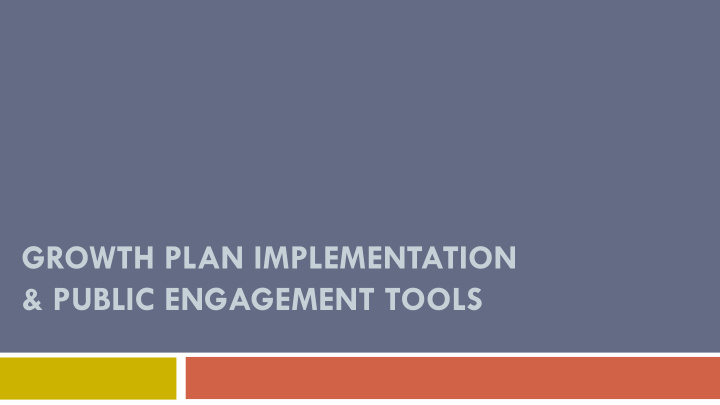



GROWTH PLAN IMPLEMENTATION & PUBLIC ENGAGEMENT TOOLS
Purpose of this Session Describe changes to the planning framework Explore public consultation opportunities and strategies Present ideas for engagement tools Conduct workshop
THE GROWTH PLAN = SMART GROWTH = HAPPY CITIES
What does Smart Growth mean? Compact neighborhoods Range of housing Mixed land options uses Happy, healthy, fair, affordable and efficient communities! Walkable, Direct transit-friendly development to neighborhood, already built-up range of areas options Preserve open space, farmland, & environmental features
Benefits of Smart Growth Congestion management Affordable housing More transportation options Lower levels of air pollution and GHG emissions Improved public health Allow aging in place Lower costs Natural areas and farmland preserved More opportunities for community involvement
The Changing Planning Landscape & Community Engagement The 2017 Growth Plan The new OMB – the Local Planning Appeal Tribunal
The New Growth Plan Official Plans must be brought into conformity with the Growth Plan within certain time-frames, first upper-tier then lower-tier Some policies can be implemented through one-off official plan amendments Others must be dealt with together through a Municipal Comprehensive Review (MCR): allocation of population and employment growth identification of growth centres and major transit station areas intensification and density targets land budget identification of expansion areas
MCR background studies, strategies and plans Intensification strategy Employment strategy Housing strategy Analysis to justify any conversions of employment areas Analysis to justify any refinements to the Natural Heritage System and/or Agricultural System Infrastructure plans for water, wastewater and transit Transportation demand management strategy
Implications for Residents Influencing downstream decisions requires intervention upstream MCR generates many entry points for citizen engagement New Growth Plan gives the upper-tier municipalities a more prominent role in the MCR
LPAT changes: The types of planning decisions that can be appealed The types of arguments that can be used in an appeal The nature of the appeal process The Local Planning Appeal Tribunal
Matters Appealed No appeal of provincial planning decisions on upper- and single tier plans and MCR decisions At the lower-tier, no appeal of intensification polices around transit stations
Arguments The LPAT rules allow only three grounds for an appeal: Inconsistency with the Provincial Policy Statement Non-conformity with the Growth Plan Conflict with an Official Plan. Only arguments introduced during council proceedings can be used
Process New procedures favour citizen involvement at LPAT: Tribunal will explain the process Local Planning Appeal Tribunal Support Centre
Implications for Residents More policy-driven planning process More public control and more opportunities for public input Consistency with the OP and Growth Plan will be key Pay attention to the upstream planning process, especially the MCR process at the upper-tier How to mobilize people for early involvement in the MCR process?
Public Engagement in Municipal Comprehensive Reviews Statutory consultation requirements Innovative engagement techniques
Legally required public consultation on OP reviews The draft plan is released to the public An open house is held Notice is given for a public meeting A special meeting of council is held The plan is approved by council
Other Options: High-touch workshops pop-up kiosks storefronts piggy-back presentations planning advisory committees walking tours
Other Options: High-tech surveys social media newsletters web portals ideas forums webinars
Public Engagement Beyond the MCR Community Planning Permit System Complete Application Requirements
Community Planning Permit System Provisions: Allows a municipality to “pre - approve” development in a whole district Municipality must adopt an OP policy then pass a separate CPP bylaw for each area Normal consultation process on development is suspended Municipality must approve applications consistent with the CPP bylaw.
Implications for Residents Win-win for developers and the municipality Double-edged sword for citizens Long time frame and limited public input after CPP bylaw is adopted. Municipal decisions on development applications are not appealable by citizens
Complete Application Requirements Permits Councils to require pre-consultation with developers Municipality can require any information or studies it needs at time of application May include studies on: Planning Transportation Cultural Engineering Urban Design Environmental Financial impact
Implications for Residents Provides citizens with early information Levels playing field Increases transparency Helps citizen argue on basis of planning merits Only a few municipalities are using it
TOOLS FOR ENGAGEMENT
Citizen Engagement Best Practices Guide An illustrated guide to innovative engagement practices: description of the technique the range of planning processes it could be applied to strengths and weaknesses URLs and other sources of information
Info-graphic Pamphlets Illustrated pamphlets that would cover issues such as: The Benefits of Smart Growth Visualizing Densities Negotiating Changes to Development Proposals
Regional Smart Growth Alliance To provide a voice for residents on planning issues: share information on successful strategies push municipalities to develop monitoring advocate for smarter growth present a united voice to call out bad developments propose changes to planning framework
Roadmap to Growth Plan Implementation Lays out the MCR process from a citizen’s point of view: overview of the MCR process with time line and key steps additional pages to drill down into each step places in the process to expect citizen engagement opportunities
Citizens’ Academy on Growth Plan Implementation Build capacity for ratepayer intervention in the Growth Plan implementation process: the MCR process at the upper-tier and single-tier levels lower-tier OP changes provincial guidance documents engagement opportunities and techniques help with communications and strategy development
Hot Spot Web Platform Tracks major development applications: location housing/building type size of building proximity to transit Walkscore LPAT outcomes
Round 1: past engagement Round 2: planned engagement Round 3: engagement tools 20 minutes per round Make notes on the workbook Return workbook WORKSHOP
Recommend
More recommend